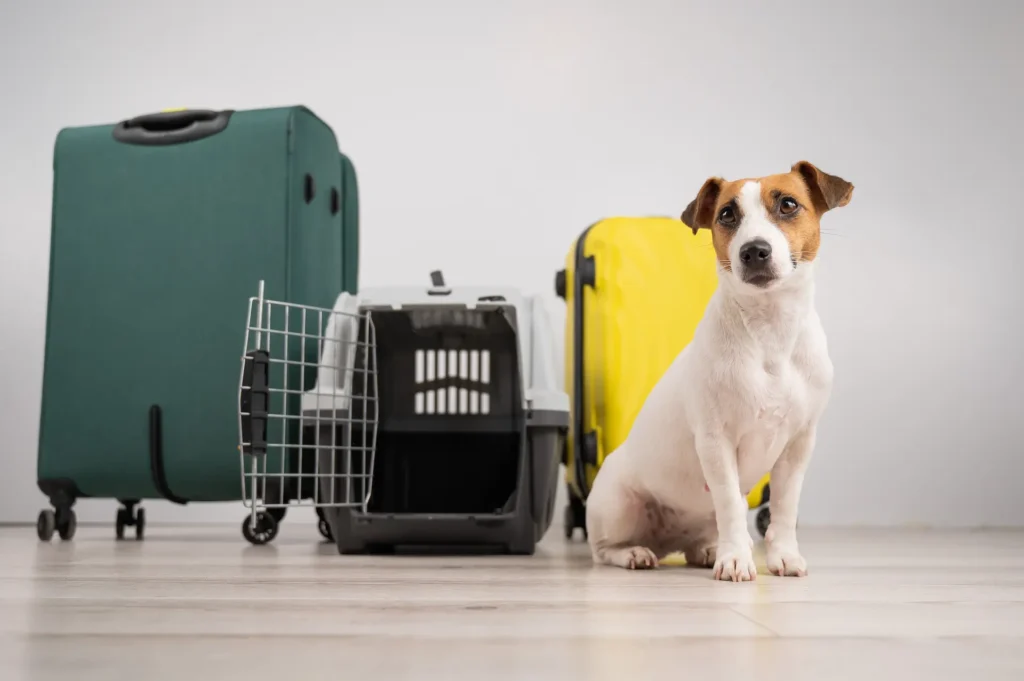Can You Board a Dog in Heat?

Yes, boarding a dog in heat is possible, although it may require special arrangements and considerations. Boarding facilities that accept dogs in heat may have separate policies for ensuring your and other dogs’ safety in the boarding facility.
A dog’s behavior can change significantly when they are in heat. Changes vary depending on the dog, the stage of its heat cycle, and the presence of other dogs. Some dogs may show subtle signs, others may show obvious ones, while some may not show any signs at all.
This article will help you understand your dog when she is in heat and how you can ensure she stays safe and happy while boarding.
Understanding the Heat Cycle in Dogs
The heat cycle is a natural physiological process that female dogs experience throughout their reproductive years. It plays a crucial role in their reproduction ability and may bring about various physical and behavioral changes.
For dog owners, a solid understanding of the heat cycle is essential for properly caring for and managing furry friends. This insight helps you make informed decisions to provide the necessary care and attention during this unique phase.
What are the signs of a dog in heat?
When a female dog enters her heat cycle, some common signs you might observe are:
- Swollen vulva: One of the earliest signs that your pet is in heat is a swollen vulva. It becomes enlarged and more prominent than usual.
- Bleeding: During the initial stages of the heat cycle, the dog tends to bleed, and you might notice a discharge from the dog’s vulva.
- Frequent urination: Female dogs in heat tend to urinate more frequently and may leave scent markings to attract males.
- Change in behavior: Dogs in heat often exhibit changes in their mood and activity level. They may become more restless, anxious, or clingy.
- Increased tail flagging: Tail flagging is when your dog raises her tail to one side, exposing her vulva. This behavior is a way to advertise herself to potential mates.
- Male attraction: Male dogs may become more interested in your female dog, with increased sniffing, licking her body, and attempting to mount her.
- Change in appetite: Some dogs experience a temporary loss of appetite or show changes in eating habits during their heat cycle.
Not all dogs display these signs in the same way. The intensity and duration can vary depending on the dog, age, breed, and stage of the heat cycle.
How long does the heat cycle last?
The duration of a heat cycle in dogs varies between two and four weeks and tends to average about three weeks. The cycle consists of several stages:
- Proestrus is the initial stage and typically lasts about 7 to 10 days. The female dog’s vulva swells, and she may exhibit signs of bleeding or a bloody discharge. However, she is not yet receptive to mating.
- Estrus is the period when the female dog is fertile and receptive to mating. It usually lasts about 5 to 10 days. The bleeding may become lighter or stop during this stage.
- Diestrus comes after the receptive phase if the female dog does not become pregnant. This stage typically lasts about 60 to 90 days. The dog’s reproductive system returns to its normal state and is not receptive to mating.
- Anestrus is the period of sexual inactivity between heat cycles. It can last for several months, and the dog’s reproductive system is at rest during this time.
These time frames are general estimates, and individual dogs may experience variations in the length and intensity of each stage. If you have any questions about your dog’s heat cycle, you should talk to your veterinarian for professional advice.
Factors to consider before boarding a dog in heat
Boarding a dog in heat requires careful consideration and planning to ensure its safety and well-being. Some factors to consider are:
- Boarding facility policy: Check with the boarding facility beforehand to ensure they accept dogs in heat. Some facilities may have specific policies or restrictions regarding dogs in heat.
- Individual dog’s behavior: Some dogs become anxious, restless, or aggressive, affecting their interactions with people or other animals. If your dog’s behavior becomes challenging during heat, it may not be suitable for boarding with other dogs.
- Safety and supervision: Consider the boarding facility’s ability to provide appropriate supervision and keep your dog safe. They should have proper measures in place to prevent accidental mating.
- Veterinary care: Check if the boarding facility has access to veterinary services. They should be able to handle any emergencies that may arise during your dog’s heat cycle.
Communicating openly with the boarding facility about your dog’s heat cycle and any specific requirements or concerns is essential. Taking these factors into account and making an informed decision helps ensure your dog’s safety and well-being during boarding.
Pros and cons of boarding a dog in heat

Boarding a dog in heat has its advantages and disadvantages:
Pros:
- Professional care: Boarding facilities have trained staff members who can provide appropriate care and monitoring for dogs in heat.
- Safety: Some boarding facilities that accept dogs in heat have specific measures and accommodations in place to keep them safe and prevent unwanted mating.
- Socialization: If the accommodation allows controlled interactions between dogs, your dog may have opportunities for socialization with other dogs, even while in heat.
- Convenience: If you have no other options available or if you’re unable to provide the required care and supervision, you can opt for boarding.
Cons:
- Stress and anxiety: The boarding experience can be stressful for some dogs, and being in heat adds additional stress. The unfamiliar environment, separation from family, and interactions with other dogs can cause anxiety and discomfort.
- Unwanted mating: Despite precautions taken by the facility, there could still be a risk of accidental mating.
- Limited boarding options: Not all boarding facilities accept dogs in heat due to the challenges and risks involved. This can limit your options and make finding a suitable boarding facility more challenging.
- Behavioral changes: Dogs in heat may exhibit changes in behavior, such as restlessness, increased vocalization, or aggression. These changes can affect their interactions with other dogs and potentially disrupt the boarding experience.
Before deciding to board your dog in heat, evaluate the pros and cons based on your dog’s specific needs, behavior, and available boarding options. Ultimately, the decision should prioritize your pet’s safety, well-being, and comfort during this time.
Tips for finding the right boarding facility
When looking for the right facility:
- Begin your search well in advance of your planned boarding dates.
- Seek recommendations from friends, family, neighbors, or your veterinarian.
- Visit the facility with your dog to assess the cleanliness, safety measures, and overall environment.
- Compare the prices and policies of different facilities, including amenities and services offered.
- Ultimately, trust your instincts and choose a facility where you feel comfortable and confident about the care of your dog.
Preparing Your Dog for Boarding
Once you have found a reputable boarding facility that meets your dog’s needs, there are some additional factors to think about:
Health requirements for boarding a dog in heat
- Vaccinations: Most boarding facilities require dogs to be up to date on their vaccinations
- Parasite prevention: Dogs should be free from internal and external parasites
- Spay/neuter status: Some boarding facilities may have specific requirements regarding the spay/neuter status of dogs
- Medications/special needs: If your dog requires medication or has any specific health needs, inform the boarding facility in advance
Health requirements are in place to protect the well-being of all dogs in the facility and to minimize the risk of disease transmission.
What to pack for your dog’s stay
Pack everything necessary for your dog’s comfort, well-being, and routine, such as:
- Favorite treats to provide comfort and reward
- Medications if needed
- Familiar bedding to provide a sense of home
- Favorite toys for entertainment
- Grooming supplies
How to ease your dog’s anxiety before boarding
To help ease your dog’s anxiety before boarding, you can:
- Familiarize your dog with the boarding facility by visiting ahead of time
- Gradually expose your dog to periods of separation
- Maintain routine in the days leading to the boarding
- Stay calm and confident, as the dog can pick up on your emotions
Dogs are unique, so you should be patient, understanding, and sensitive to your dog’s individual needs.
What to Expect When Boarding a Dog in Heat
Boarding a dog in heat can be a challenging situation for both owner and dog. Some things to expect and prepare for include:
Boarding facility protocols for dogs in heat
You should contact the facility beforehand and ask about their policies and requirements for dogs in heat.
Handling your dog’s behavior while in heat
In order to help keep your dog comfortable, pack essentials such as food, toys, and any medications they may need.
Communication with the boarding facility
Keep in touch with the facility and check on your dog’s condition regularly.
After Boarding Your Dog in Heat
After fetching your dog from the facility, there are a few things to do to ensure her well-being:
Postboarding care for your dog
Give your dog some time to rest, as she may be tired or stressed after the stay in the facility. Reinforce their training and spend quality time with your dog to ensure they are happy and healthy.
What to do if your dog shows signs of illness
It’s important to take prompt action to ensure the health and well-being of your dog, and if there are signs of illness after boarding:
- Observe the symptoms your dog is showing
- Contact the facility about your dog’s condition to help identify potential sources of infection
- Consult your veterinarian as soon as possible
- Isolate your dog if necessary
Dogs in heat may require additional monitoring and care, as they may experience behavioral changes, increased anxiety, and physical discomfort. For a boarding facility that provides care for your dog in heat, choose the Forest Shadows Pet Resort. We give your pet a home away from home in Magnolia, TX!
FAQs: Frequently Asked Questions
Q: Can I take my dog out when she’s in heat?
It’s generally recommended to restrict outdoor activities and avoid taking public walks to prevent unwanted attention from male dogs.
Q: Do dog kennels take dogs in heat?
Some kennels may accept dogs on heat, and others may not. You should contact the kennel beforehand and ask about their policies for dogs on heat.
Q: What not to do when your dog is in heat?
- Avoid off-leash walks
- Prevent unsupervised outdoor time
- Don’t encourage or allow mating
- Avoid dog parks and public areas
Q: Can I put my dog in kennels in season?
Yes, although many boarding kennels have their own policies regarding dogs in heat. It’s important to check with the kennel you plan to use.
